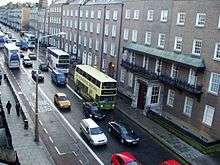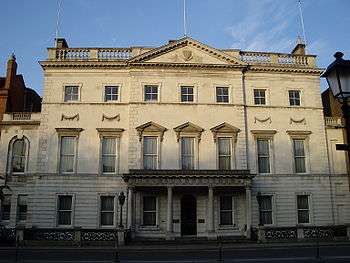Leeson Street
.jpg)
Leeson Street (Irish: Sráid Líosain) is a thoroughfare near central Dublin, Ireland. The street is divided into two parts by the Grand Canal: Lower Leeson Street, in Dublin 2 is to the north of the canal, linking to St Stephen's Green, with Upper Leeson Street, in the Dublin 4 region, south of the canal. Originally known as Suesey Street, it was renamed in 1728 after the Leesons, a family of local brewers, who branched into property development and subsequently became Earls of Milltown. In 1767 a Magdalen Asylum was established by Lady Arabella Denny in the street for Protestant women.[1]
The street is home to several prominent buildings including the main office of the Ombudsman and the embassies of Portugal, Malta, and Cyprus.[2] The largest building on Lower Leeson Street, along with several adjoining buildings and significant land holdings in the area, is owned by the Catholic University School.
In 1990, Caravaggio's lost masterpiece, The Taking of Christ, was recognised in the residence of the Jesuit Communication Centre on Lower Leeson Street.[3][4] Broadcaster Gerry Ryan lived and died on this street.[5]
Gallery
 Lower Leeson Street junction with Earlsfort Terrace and St Stephen's Green
Lower Leeson Street junction with Earlsfort Terrace and St Stephen's Green Lower Leeson Street
Lower Leeson Street Bus lane on Lower Leeson Street
Bus lane on Lower Leeson Street Upper Leeson Street
Upper Leeson Street Upper Leeson Street
Upper Leeson Street Grand Canal at Leeson Street Bridge
Grand Canal at Leeson Street Bridge Iveagh House, adjacent to Lower Leeson Street
Iveagh House, adjacent to Lower Leeson Street
See also
References
- ↑ Kilfeather, Siobhán Marie (2005). Dublin: A Cultural History. New York: Oxford University Press. p. 258. ISBN 978-0-19-518202-6.
- ↑ About us, Office of the Ombudsman
- ↑ Walshe, Elaine (2013–14). "A Picture Of Mystery". The Irish Letter. Retrieved 6 January 2015.
- ↑ "The Taking of Christ, Caravaggio". National Gallery of Ireland. 16 October 2014. Retrieved 6 January 2015.
- ↑ "Gerry Ryan found dead". Irish Examiner. 30 April 2010. Retrieved 30 April 2010.